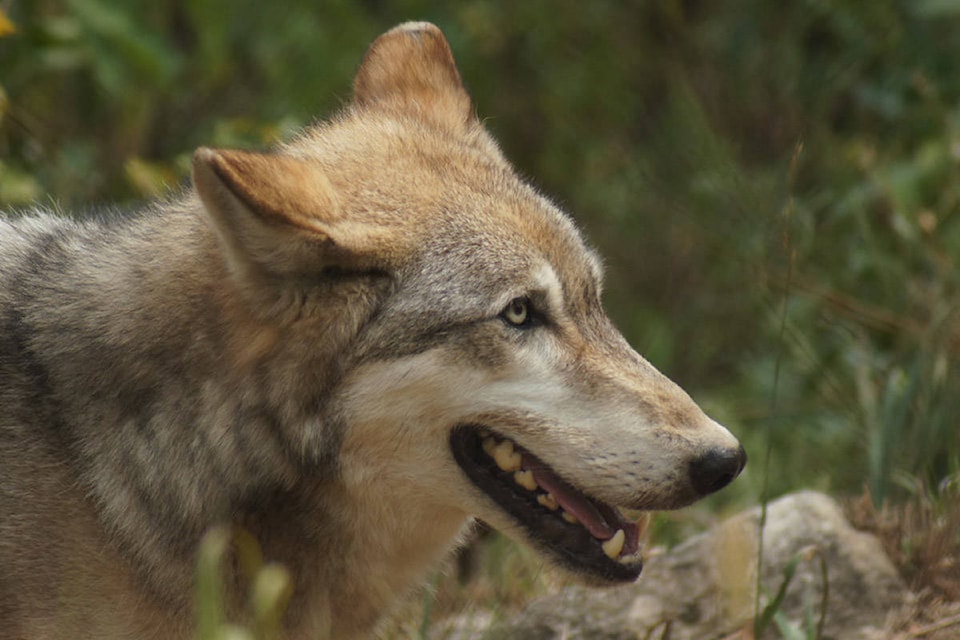A recent wolf sighting in Campbell River raised questions about the animal’s conservation status on Vancouver Island, and whether wolves are responsible for reduced numbers of animals including deer and marmots.
Chris Darimont, a leading wolf expert and Raincoast Research Chair at the University of Victoria, says there’s no immediate threat to wolf populations on Vancouver Island, and forestry practices, not wolf populations, are to blame for a decline in animals such as deer.
“They’re a convenient scapegoat,” Darimont said in an interview. “But decades of research… reveal very little evidence that wolves cause declines in prey populations.”
Predator and prey systems are largely self-regulating, he said, meaning a decline in deer generally goes hand-in-hand with a decline in wolves.
And even if wolves hunt the Vancouver Island marmot as a “rare meal,” it isn’t wolves that are at the root of the problem.
A common cause for the decline of both animals is forestry practices, he said.
“The demise of marmots and the decline in deer share a common cause, and that is whole-scale conversion of ancient forests into a series of logging roads and tree plantations,” he said. “We should be reconsidering how forests are managed.”
As for the status of the grey wolf, the animal has been wiped out throughout the coastal United States, where they used to occur. Their southern limit tends to be Sooke on Vancouver Island and Howe Sound near Vancouver, Darimont said.
READ MORE: Wolf attacks dog in Vancouver Island First Nation community
Wolves have also lost large areas of range along the built-up areas of eastern Vancouver Island roughly from Campbell River to Victoria, he said.
In other areas, wolves are likely in lower abundance than they were, Darimont said, due to forestry practices that convert old-growth forests into “tree plantations” that support less deer.
Information posted on the website VI-Wilds states that Vancouver Island wolves are a subspecies that’s considered endangered and that less than 150 were estimated on the Island in 2008.
However, there’s no “immediate catastrophic threat” to wolves on the Island, according to Darimont.
“They are, in the short term, reasonably secure here on Vancouver Island,” he said.
Wolves were formerly subject to government-sponsored eradication campaigns and were thought to have disappeared entirely from the Island decades ago, he said, citing a 2010 research paper that he co-authored.
As for the designation of “subspecies,” Darimont said few scientists in his field would use that terminology anymore.
He said that wolves are good swimmers known to travel to and from the mainland. This has resulted in a mixing of their genes into an “evolutionarily significant unit.”
VIDEO: Takaya, the lone wolf that roams two B.C. islands, spotted on beach
Wolves often go into populated areas, but cellphone cameras have turned these sightings into news, he said. Recent examples include cellphone footage of a wolf swimming across the Discovery Passage in Campbell River on June 29.
“The difference is these days everyone’s connected by social media,” he said.
The Ministry of Forests said in a statement that Vancouver Island wolves aren’t recognized as a distinct subspecies, and that evidence points to ongoing dispersal of wolves to and from the mainland.
“(T)his has likely resulted in frequent transfer of genes between wolves in these areas of relative geographic proximity,” according to the statement.
The grey wolf is considered “not at risk” by the Committee on the Status of Endangered Wildlife in Canada, and its provincial conservation status is “apparently secure to demonstrably widespread, abundant, and secure.” The ministry describes the wolf as “widespread and abundant on Vancouver Island.”
There are “more than 250 wolves on Vancouver Island at this time and the population is increasing,” according to estimates from the Ministry of Forests.
Darimont said in an email it’s likely true that more than 250 live on Vancouver Island, but there’s “no evidence I’m aware of that they are increasing (or decreasing for that matter).”
@davidgordonkoch
david.koch@campbellrivermirror.com
Like us on Facebook and follow us on Twitter
